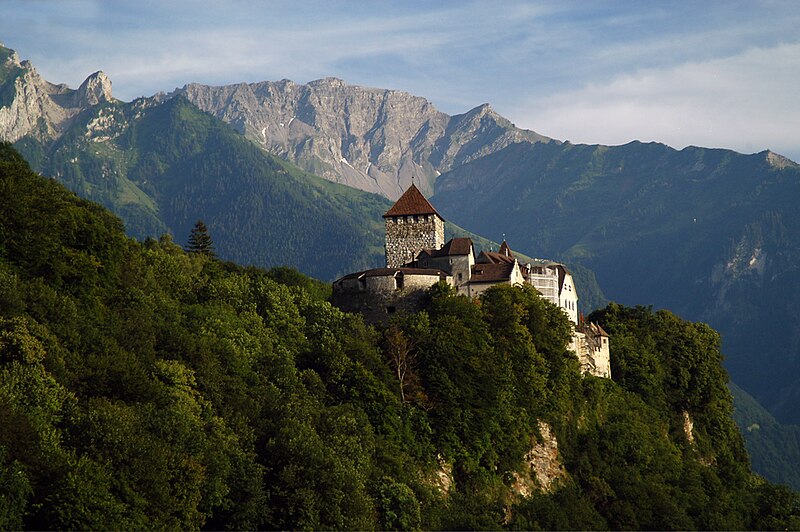by Susan Flantzer © Unofficial Royalty 2015

Photo Credit – Wikipedia
Franz Josef II, Prince of Liechtenstein (Franz Josef Maria Aloys Alfred Karl Johannes Heinrich Michael Georg Ignatius Benediktus Gerhardus Majella) was born August 16, 1906, at Schloss Frauenthal in Steiermark, Austria. He was the eldest of the eight children of Prince Aloys of Liechtenstein and Archduchess Elisabeth Amalie of Austria, who was the half-sister of Archduke Franz Ferdinand of Austria, whose assassination was one of the factors that led to World War I.
Franz Josef had five brothers and two sisters:
- Princess Maria Theresia (1908 – 1973), married Count Arthur Strachwitz von Gross-Zauche und Camminetz, had issue
- Prince Karl Alfred (1910 – 1985), married Archduchess Agnes Christina of Austria, had issue
- Prince Georg Hartmann (1911 – 1998), married Duchess Marie Christine of Württemberg, had issue
- Prince Ulrich Dietmar (1913 – 1978), unmarried
- Princess Marie Henriette (1914 – 2011), married Count Peter von Eltz genannt Faust von Stromberg, had issue
- Prince Aloys Heinrich (1917 – 1967), unmarried
- Prince Heinrich Hartneid (1920 – 1993), married Countess Amalie von Podstatzky-Lichtenstein, had issue
Franz Josef was named after Franz Joseph I, Emperor of Austria who was his mother’s paternal uncle and his godfather. He grew up in the Austrian castles of the Princely House of Liechtenstein where he developed his love of nature which influenced his future studies. Franz Josef’s father, Prince Aloys of Liechtenstein was the son of Prince Alfred of Liechtenstein and Princess Henriette of Liechtenstein, daughter of Aloys II, Prince of Liechtenstein. On February 26, 1923, Prince Aloys renounced his rights to the succession in favor of his son Franz Josef. At the time, Prince Aloys was the second in the line of succession behind his childless uncle Franz who succeeded to the throne in 1929 as Franz I, Prince of Liechtenstein.
In 1925, Franz Josef graduated from the Schottengymnasium in Vienna, Austria. He then enrolled at the University of Natural Resources and Life Sciences in Vienna, Austria where he studied forestry. In 1930, Franz Josef graduated with distinction from the university as a forest engineer. He used his forestry skills on the family-owned farms, then in Czechoslovakia, now part of the Czech Republic.
Franz Josef took on various official roles on behalf of the elderly Prince Franz I. On March 30, 1938, Franz I named Franz Josef regent. Although he cited old age as his reason for the regency, it is widely believed that it was because he had no desire to be ruling if Nazi Germany invaded his small principality. Franz I died on July 25, 1938, and was succeeded by his grandnephew, Franz Josef II.
During World War II, Liechtenstein remained officially neutral. Family treasures from Bohemia, Moravia, and Silesia were taken to Liechtenstein for safekeeping. At the end of World War II, Czechoslovakia and Poland seized all of Liechtenstein’s property in Bohemia, Moravia, and Silesia which included large areas of farms and forests and several family castles and palaces. Prior to World War II, the family burial place was the Princely Mausoleum which was in Vranov, Czechoslovakia (now the Czech Republic) after the war. The Princely Mausoleum was also seized after World War II. Since then, the Czech Republic has refused to return the property to the Princely Family of Liechtenstein, and there has been no preservation or restoration of the tombs and mausoleum.
Franz Josef was the first sovereign prince to live full-time in the principality and made his home at Vaduz Castle.

Vaduz Castle; Photo Credit – Wikipedia, photo by Michael Gredenberg
On March 7, 1943, Franz Joseph married Countess Georgina von Wilczek (Gina) at St. Florian Cathedral in Vaduz, Liechtenstein.
The couple had five children:
- Hans-Adam II, Prince of Liechtenstein (born 1945), married Countess Marie Aglaë von Wchinitz und Tettau, had three sons and one daughter
- Prince Philipp of Liechtenstein (born 1946), married Isabelle de l’Arbre de Malander, had three sons
- Prince Nikolaus of Liechtenstein (born 1947), married Princess Margaretha of Luxembourg, had two sons and two daughters
- Princess Nora of Liechtenstein (born 1950), married Vicente Sartorius y Cabeza de Vaca, 3rd Marqués de Mariño, had one daughter
- Prince Wenzel of Liechtenstein (1962 – 1991), unmarried
After World War II, the economic, social, and cultural progress of Liechtenstein was Franz Josef’s chief concern. The family often resorted to selling family art treasures, including the portrait “Ginevra de’ Benci” by Leonardo da Vinci, which was purchased by the National Gallery of Art of the United States in 1967 for $5 million ($35 million in 2015 dollars), then a record price for a painting. By the late 1970s, Liechtenstein used its low corporate tax rates to draw many companies to the country, becoming one of the wealthiest countries in the world. Today, Liechtenstein has the second-highest per capita income in the world.
In 1984, Franz Josef II handed over most of his powers to his son Hans-Adam. After 46 years of marriage, Princess Gina died on October 18, 1989, at the age of 68 after a long battle with cancer. She had once said. “My husband and I have become one. Everyone believes we are not able to exist without the other.” Only 26 days after the death of his wife, Prince Franz Josef II died on November 13, 1989, in a hospital in Grabs, Switzerland at the age of 83. The couple was buried in the Princely Crypt at St. Florian Cathedral in Vaduz, Liechtenstein.
This article is the intellectual property of Unofficial Royalty and is NOT TO BE COPIED, EDITED, OR POSTED IN ANY FORM ON ANOTHER WEBSITE under any circumstances. It is permissible to use a link that directs to Unofficial Royalty.
Principality of Liechtenstein Resources at Unofficial Royalty


